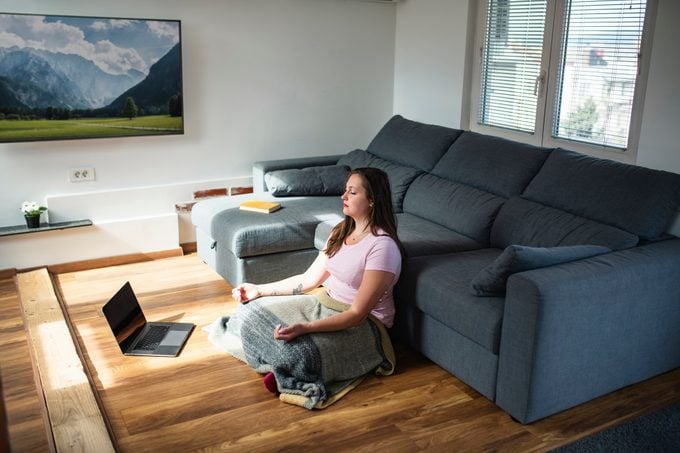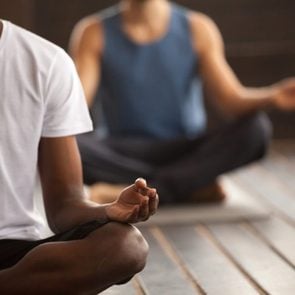Calm Your Mind for Free with These No-Cost Meditation Solutions
Updated: Jun. 09, 2021
Before shelling out big bucks on a meditation course, check out these free meditation sources and see how they feel.
Skills for stress
Tossing and turning at night? Snapping at your kids for no good reason? Stress-eating? You’re not alone.
And this is why millions of people are turning to meditation to help improve their physical and mental health—especially as we trudge through the ongoing Covid-19 pandemic and navigate the restrictions it has placed on our lives.
“During this time of crisis, we need ways to de-stress and skills to help us manage our challenging emotions, to cultivate positive emotions, and to find a place of balance within us,” says Diana Winston, director of mindfulness education at the UCLA Mindful Awareness Research Center (MARC) in Los Angeles and the author of The Little Book of Being.
And meditation ticks all the boxes, she says. You don’t even need much to get started except a quiet spot, a chunk of time (even as little as five minutes will do), and an open mind.
As Neda Gould, PhD, director of the mindfulness program at Johns Hopkins University in Baltimore, puts it: All of the tools needed to learn how to meditate are available within your mind and body, including your breath and five senses.
How meditation works
At its heart, meditation, regardless of which type you practice, is about quieting your mind by focusing on something other than your to-do list or racing thoughts.
Your focus can be your breath, a mantra that is repeated or chanted over and over, a sound or a visualization, for example. This shift in attention helps you to become fully present in the moment without distraction, setting the stage for clarity.
When you are anxious or stressed out, your body’s fight or flight response kicks in, releasing stress hormones that cause your heart to race, your breath to quicken, and your blood pressure to rise.
This is great when you are in physical danger, but not so great when you are stuck in traffic or dwelling on a toxic relationship. Studies show that meditation can help your brain turn this response down more readily, says Gould.
If you meditate regularly, you will see improvements in your mental and physical health, including less anxiety and depression, better sleep, lower blood pressure, and more.
In a study of close to 700 teachers in the Wisconsin public school system, meditating with the free HealthyMinds Program app for as few as five minutes a day produced dramatic benefits.
“Teachers reported lower levels of perceived stress and depression, and absenteeism went down, all during the highly stressful Covid-19 pandemic,” says Cortland Dahl, PhD, chief contemplative officer at HealthyMinds Innovations and a research scientist at the Center for Healthy Minds at the University of Wisconsin-Madison.
(This data is yet to be peer-reviewed and is published in preprint form at the archival site PsyArXiv.)
“Reductions continued to grow and were sustained at three months later and on par with the benefits seen with in-person interventions including therapy,” says Cortland Dahl. “Just five to 20 minutes makes a big difference, and the teachers who were really stressed seemed to get the most benefit.”
A regular meditation practice benefits students too. (This school replaced detention with meditation—and the results are mind-blowing.)
Where can you sign up? Before shelling out any cash, check out these 6 free ways to calm your body and mind.
Download a free app or two
There’s an app for everything these days so, of course, there are several that can teach you how to meditate, many of which are totally free, including UCLA Mindful, Smiling Mind, and the HealthyMinds Program App.
“On our UCLA app you can start with a five-minute meditation and slowly increase over time to 15 minutes or an amount that makes sense in your life,” says Winston.
Even leading commercial meditation apps such as Insight Timer, 10% Happier, Calm, and Headspace have free versions, and you can always pay for more enhanced services.
You can try out various meditation practices and styles to see which one works best for you, including mindfulness, where you pay attention to your body and thoughts, often focusing on the breath; or movement meditation, where you focus on your body, often breathing in time with your footsteps.
Whatever the app or apps you download, there will be meditations geared toward the trait, temperament, or tendency that you are hoping to improve. Do you want to be happier? Less stressed about the small stuff? Sleep better? Be more patient with your kids? You name it, and there’s a meditation for it.
You don’t need to dive in headfirst right away either. Apps like Insight Timer offer a free seven-day course to help you get started and master the basics. Check out these 9 free meditation apps that experts love.
Teach yourself
Spoiler alert: You don’t really need a teacher, coach, or even an app to try meditation, Winston says. Simply begin by noticing your breathing, feeling the rise and fall of your chest or abdomen, or the in-and-out sensations at your nose.
Your attention will wander, and when it does, rein it back in to your breathing. Keep doing this over and over…and voila, you are meditating.
It takes time to cultivate a practice and start reaping the benefits of meditation, she says.
“Once you understand how to train your attention, learning to bring your mind into the present moment via the meditation, then you can practice mindfulness throughout the day,” Winston says. “When you start worrying about the future, you can take a mindful pause, coming into the present moment, feeling your feet on the floor, or taking a mindful breath.”
She adds, “When you feel cooped in and are about to yell at your child or make an annoyed comment to your partner, you can check in with yourself, taking a pause, and not being so reactive.” Try these different meditation positions to see which works best for you.

Get grounded
Focusing on your breathing is one way to meditate, but there are other methods that can be self-taught for free too. Gould often recommends this grounding exercise to stop negative or disruptive thought patterns in the moment.
- Name five things you see.
- Name four things you can touch.
- Name three things you can hear.
- Name two things you can smell.
- Name one that you can taste.
That’s all there is to it, and usually by the end of the exercise, your focus has shifted to the present.
(Need some inspiration? These 16 meditation quotes will help you stay grounded.)
Watch some how-to videos
Try entering phrases like “learn to meditate for free” or “free meditation videos” into your search bar. You will quickly come across free guided sessions on YouTube and other video-sharing websites geared to all ages and stages, including meditating for beginners with actor Russell Brand.
You can learn how to meditate like a Buddhist monk if you are so inclined or learn the ropes from the masters like Deepak Chopra or Jon Kabat-Zinn, founder of mindfulness-based stress reduction (MBSR).
Audit classes
These offerings are largely online due to Covid-19 and the social distancing restrictions that are still in place, but as more people get vaccinated, in-person classes will likely start opening up near you.
Some free meditation classes and guided meditation recordings are available at UCLA. Brown University also offers free meditation sessions as does UC San Diego.
There’s no nationally recognized certifying body for meditation programs or coaches yet, says Dahl.
“Meditation is where yoga was years ago, and now there are certifying bodies for yoga teachers and courses, but that hasn’t happened yet in the mindfulness or meditation world.”
Many universities and health care systems have reputable programs, so these are good places to start looking for free classes.
Listen in
If you prefer to listen and learn, there are many free audio resources to help you start or hone your meditation practice. Mindful lists some popular ones.
Say you learn by reading. Then these eight mini meditations from the book The End of Stress can help calm your mind and make you feel happier.
Starting a habit
Poke around a little bit, Dahl says. “If you find the app or free introductory class that works for you and you do want to go deeper, maybe consider a course that would cost money down the line.” These meditation gifts are also a great way to aid your practice (or someone else’s).
There are a lot of options to get you started on your path to Zen, and many of them are free. “Experiment and try a few things and see what resonates with you,” Dahl says. The key is to make it a habit.
Next up, check out 10 ways to sneak meditation into your everyday life.


















